[English] 日本語
 Yorodumi
Yorodumi- PDB-1osv: STRUCTURAL BASIS FOR BILE ACID BINDING AND ACTIVATION OF THE NUCL... -
+ Open data
Open data
- Basic information
Basic information
| Entry | Database: PDB / ID: 1osv | ||||||
|---|---|---|---|---|---|---|---|
| Title | STRUCTURAL BASIS FOR BILE ACID BINDING AND ACTIVATION OF THE NUCLEAR RECEPTOR FXR | ||||||
 Components Components |
| ||||||
 Keywords Keywords |  DNA BINDING PROTEIN / LBD / DNA BINDING PROTEIN / LBD /  bile acid / bile acid /  coactivator / coactivator /  nuclear receptor nuclear receptor | ||||||
| Function / homology |  Function and homology information Function and homology informationresponse to norepinephrine / Endogenous sterols / Synthesis of bile acids and bile salts / Recycling of bile acids and salts / Synthesis of bile acids and bile salts via 27-hydroxycholesterol / Synthesis of bile acids and bile salts via 7alpha-hydroxycholesterol / negative regulation of triglyceride biosynthetic process / Activated PKN1 stimulates transcription of AR (androgen receptor) regulated genes KLK2 and KLK3 / Recycling of bile acids and salts / Synthesis of bile acids and bile salts via 7alpha-hydroxycholesterol ...response to norepinephrine / Endogenous sterols / Synthesis of bile acids and bile salts / Recycling of bile acids and salts / Synthesis of bile acids and bile salts via 27-hydroxycholesterol / Synthesis of bile acids and bile salts via 7alpha-hydroxycholesterol / negative regulation of triglyceride biosynthetic process / Activated PKN1 stimulates transcription of AR (androgen receptor) regulated genes KLK2 and KLK3 / Recycling of bile acids and salts / Synthesis of bile acids and bile salts via 7alpha-hydroxycholesterol / Synthesis of bile acids and bile salts via 27-hydroxycholesterol / Synthesis of bile acids and bile salts / regulation of carbohydrate metabolic process / positive regulation of glucocorticoid receptor signaling pathway /  regulation of lipid storage / Endogenous sterols / HATs acetylate histones / hepatocyte proliferation / regulation of bile acid secretion / regulation of urea metabolic process / intracellular bile acid receptor signaling pathway / regulation of lipid storage / Endogenous sterols / HATs acetylate histones / hepatocyte proliferation / regulation of bile acid secretion / regulation of urea metabolic process / intracellular bile acid receptor signaling pathway /  chenodeoxycholic acid binding / positive regulation of phosphatidic acid biosynthetic process / positive regulation of glutamate metabolic process / positive regulation of ammonia assimilation cycle / negative regulation of collagen biosynthetic process / bile acid receptor activity / regulation of low-density lipoprotein particle clearance / intracellular triglyceride homeostasis / cellular response to bile acid / SUMOylation of intracellular receptors / Regulation of lipid metabolism by PPARalpha / Nuclear Receptor transcription pathway / negative regulation of very-low-density lipoprotein particle remodeling / Cytoprotection by HMOX1 / negative regulation of interleukin-1 production / leukocyte migration involved in inflammatory response / nuclear glucocorticoid receptor binding / Estrogen-dependent gene expression / regulation of insulin secretion involved in cellular response to glucose stimulus / cellular response to organonitrogen compound / toll-like receptor 9 signaling pathway / triglyceride homeostasis / nuclear retinoic acid receptor binding / negative regulation of monocyte chemotactic protein-1 production / intracellular receptor signaling pathway / bile acid metabolic process / digestive tract development / bile acid and bile salt transport / response to cholesterol / cell-cell junction assembly / positive regulation of female receptivity / chenodeoxycholic acid binding / positive regulation of phosphatidic acid biosynthetic process / positive regulation of glutamate metabolic process / positive regulation of ammonia assimilation cycle / negative regulation of collagen biosynthetic process / bile acid receptor activity / regulation of low-density lipoprotein particle clearance / intracellular triglyceride homeostasis / cellular response to bile acid / SUMOylation of intracellular receptors / Regulation of lipid metabolism by PPARalpha / Nuclear Receptor transcription pathway / negative regulation of very-low-density lipoprotein particle remodeling / Cytoprotection by HMOX1 / negative regulation of interleukin-1 production / leukocyte migration involved in inflammatory response / nuclear glucocorticoid receptor binding / Estrogen-dependent gene expression / regulation of insulin secretion involved in cellular response to glucose stimulus / cellular response to organonitrogen compound / toll-like receptor 9 signaling pathway / triglyceride homeostasis / nuclear retinoic acid receptor binding / negative regulation of monocyte chemotactic protein-1 production / intracellular receptor signaling pathway / bile acid metabolic process / digestive tract development / bile acid and bile salt transport / response to cholesterol / cell-cell junction assembly / positive regulation of female receptivity /  bile acid binding / bile acid signaling pathway / nuclear thyroid hormone receptor binding / negative regulation of interleukin-2 production / cellular response to fatty acid / RNA polymerase II intronic transcription regulatory region sequence-specific DNA binding / positive regulation of interleukin-17 production / locomotor rhythm / positive regulation of insulin secretion involved in cellular response to glucose stimulus / intracellular glucose homeostasis / negative regulation of interleukin-6 production / bile acid binding / bile acid signaling pathway / nuclear thyroid hormone receptor binding / negative regulation of interleukin-2 production / cellular response to fatty acid / RNA polymerase II intronic transcription regulatory region sequence-specific DNA binding / positive regulation of interleukin-17 production / locomotor rhythm / positive regulation of insulin secretion involved in cellular response to glucose stimulus / intracellular glucose homeostasis / negative regulation of interleukin-6 production /  aryl hydrocarbon receptor binding / negative regulation of type II interferon production / regulation of lipid metabolic process / cellular response to Thyroglobulin triiodothyronine / negative regulation of tumor necrosis factor production / regulation of glucose metabolic process / negative regulation of tumor necrosis factor-mediated signaling pathway / fatty acid homeostasis / response to glucose / aryl hydrocarbon receptor binding / negative regulation of type II interferon production / regulation of lipid metabolic process / cellular response to Thyroglobulin triiodothyronine / negative regulation of tumor necrosis factor production / regulation of glucose metabolic process / negative regulation of tumor necrosis factor-mediated signaling pathway / fatty acid homeostasis / response to glucose /  DNA polymerase binding / nuclear retinoid X receptor binding / negative regulation of canonical NF-kappaB signal transduction / positive regulation of insulin receptor signaling pathway / regulation of cellular response to insulin stimulus / DNA polymerase binding / nuclear retinoid X receptor binding / negative regulation of canonical NF-kappaB signal transduction / positive regulation of insulin receptor signaling pathway / regulation of cellular response to insulin stimulus /  Notch signaling pathway / cellular response to hormone stimulus / positive regulation of adipose tissue development / peroxisome proliferator activated receptor signaling pathway / response to nutrient levels / cholesterol homeostasis / nuclear receptor coactivator activity / response to progesterone / Notch signaling pathway / cellular response to hormone stimulus / positive regulation of adipose tissue development / peroxisome proliferator activated receptor signaling pathway / response to nutrient levels / cholesterol homeostasis / nuclear receptor coactivator activity / response to progesterone /  liver regeneration / nuclear estrogen receptor binding / liver regeneration / nuclear estrogen receptor binding /  transcription coregulator binding / transcription coregulator binding /  nuclear receptor binding / RNA polymerase II transcription regulatory region sequence-specific DNA binding / nuclear receptor binding / RNA polymerase II transcription regulatory region sequence-specific DNA binding /  peptide binding / circadian regulation of gene expression / peptide binding / circadian regulation of gene expression /  euchromatin / mRNA transcription by RNA polymerase II / response to organic cyclic compound / negative regulation of inflammatory response / euchromatin / mRNA transcription by RNA polymerase II / response to organic cyclic compound / negative regulation of inflammatory response /  circadian rhythm / RNA polymerase II transcription regulator complex / response to estrogen / circadian rhythm / RNA polymerase II transcription regulator complex / response to estrogen /  nuclear receptor activity nuclear receptor activitySimilarity search - Function | ||||||
| Biological species |   Rattus norvegicus (Norway rat) Rattus norvegicus (Norway rat) | ||||||
| Method |  X-RAY DIFFRACTION / X-RAY DIFFRACTION /  SYNCHROTRON / SYNCHROTRON /  MOLECULAR REPLACEMENT / Resolution: 2.5 Å MOLECULAR REPLACEMENT / Resolution: 2.5 Å | ||||||
 Authors Authors | Mi, L.Z. / Devarakonda, S. / Harp, J.M. / Han, Q. / Pellicciari, R. / Willson, T.M. / Khorasanizadeh, S. / Rastinejad, F. | ||||||
 Citation Citation |  Journal: Mol.Cell / Year: 2003 Journal: Mol.Cell / Year: 2003Title: Structural Basis for Bile Acid Binding and Activation of the Nuclear Receptor FXR Authors: Mi, L.Z. / Devarakonda, S. / Harp, J.M. / Han, Q. / Pellicciari, R. / Willson, T.M. / Khorasanizadeh, S. / Rastinejad, F. | ||||||
| History |
|
- Structure visualization
Structure visualization
| Structure viewer | Molecule:  Molmil Molmil Jmol/JSmol Jmol/JSmol |
|---|
- Downloads & links
Downloads & links
- Download
Download
| PDBx/mmCIF format |  1osv.cif.gz 1osv.cif.gz | 116.1 KB | Display |  PDBx/mmCIF format PDBx/mmCIF format |
|---|---|---|---|---|
| PDB format |  pdb1osv.ent.gz pdb1osv.ent.gz | 91.5 KB | Display |  PDB format PDB format |
| PDBx/mmJSON format |  1osv.json.gz 1osv.json.gz | Tree view |  PDBx/mmJSON format PDBx/mmJSON format | |
| Others |  Other downloads Other downloads |
-Validation report
| Arichive directory |  https://data.pdbj.org/pub/pdb/validation_reports/os/1osv https://data.pdbj.org/pub/pdb/validation_reports/os/1osv ftp://data.pdbj.org/pub/pdb/validation_reports/os/1osv ftp://data.pdbj.org/pub/pdb/validation_reports/os/1osv | HTTPS FTP |
|---|
-Related structure data
- Links
Links
- Assembly
Assembly
| Deposited unit | 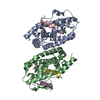
| ||||||||
|---|---|---|---|---|---|---|---|---|---|
| 1 | 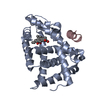
| ||||||||
| 2 | 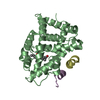
| ||||||||
| Unit cell |
| ||||||||
| Details | The biological assembly is one of the two subunits in the asymmetric unit - A or B |
- Components
Components
| #1: Protein | Mass: 26850.891 Da / Num. of mol.: 2 / Fragment: ligand binding domain (FXR-LBD) Source method: isolated from a genetically manipulated source Source: (gene. exp.)   Rattus norvegicus (Norway rat) / Plasmid: pET16b / Species (production host): Escherichia coli / Production host: Rattus norvegicus (Norway rat) / Plasmid: pET16b / Species (production host): Escherichia coli / Production host:   Escherichia coli BL21(DE3) (bacteria) / Strain (production host): BL21(DE3) / References: UniProt: Q62735 Escherichia coli BL21(DE3) (bacteria) / Strain (production host): BL21(DE3) / References: UniProt: Q62735#2: Protein/peptide |  / NCoA-2 / Transcription intermediary factor 2 / Glucocorticoid receptor-interacting protein 1 / GRIP-1 / NCoA-2 / Transcription intermediary factor 2 / Glucocorticoid receptor-interacting protein 1 / GRIP-1Mass: 1464.664 Da / Num. of mol.: 3 / Fragment: Residues (741-752) / Source method: obtained synthetically Details: The coactivator peptide was synthesized. The sequence of the GRIP is naturally found in Rattus Norvegicus (Norway Rat). References: UniProt: Q61026 #3: Chemical |  Obeticholic acid Obeticholic acid#4: Water | ChemComp-HOH / |  Water Water |
|---|
-Experimental details
-Experiment
| Experiment | Method:  X-RAY DIFFRACTION / Number of used crystals: 1 X-RAY DIFFRACTION / Number of used crystals: 1 |
|---|
- Sample preparation
Sample preparation
| Crystal | Density Matthews: 3.12 Å3/Da / Density % sol: 60.31 % | ||||||||||||||||||||||||||||||||||||||||||||||||||||||||
|---|---|---|---|---|---|---|---|---|---|---|---|---|---|---|---|---|---|---|---|---|---|---|---|---|---|---|---|---|---|---|---|---|---|---|---|---|---|---|---|---|---|---|---|---|---|---|---|---|---|---|---|---|---|---|---|---|---|
Crystal grow | Temperature: 283 K / Method: vapor diffusion, hanging drop / pH: 6.4 Details: PEG 8000,Ethylene Glycol, PIPES , pH 6.4, VAPOR DIFFUSION, HANGING DROP, temperature 283K | ||||||||||||||||||||||||||||||||||||||||||||||||||||||||
| Crystal grow | *PLUS pH: 8 / Method: vapor diffusion, hanging drop | ||||||||||||||||||||||||||||||||||||||||||||||||||||||||
| Components of the solutions | *PLUS
|
-Data collection
| Diffraction | Mean temperature: 100 K |
|---|---|
| Diffraction source | Source:  SYNCHROTRON / Site: SYNCHROTRON / Site:  APS APS  / Beamline: 19-BM / Wavelength: 1.0332 Å / Beamline: 19-BM / Wavelength: 1.0332 Å |
| Detector | Type: ADSC QUANTUM 4 / Detector: CCD / Date: Nov 19, 2002 |
| Radiation | Monochromator: graphite / Protocol: SINGLE WAVELENGTH / Monochromatic (M) / Laue (L): M / Scattering type: x-ray |
| Radiation wavelength | Wavelength : 1.0332 Å / Relative weight: 1 : 1.0332 Å / Relative weight: 1 |
| Reflection | Resolution: 2.5→24.3 Å / Num. all: 26840 / Num. obs: 24908 / Observed criterion σ(F): 3 / Observed criterion σ(I): 3 / Redundancy: 4 % / Biso Wilson estimate: 44.2 Å2 / Rsym value: 0.044 / Net I/σ(I): 19.61 |
| Reflection shell | Resolution: 2.5→2.59 Å / Redundancy: 3.4 % / Mean I/σ(I) obs: 3.04 / Rsym value: 0.282 / % possible all: 77.2 |
| Reflection | *PLUS Lowest resolution: 24.3 Å / Num. obs: 24427 / % possible obs: 92.8 % / Num. measured all: 99829 / Rmerge(I) obs: 0.044 |
| Reflection shell | *PLUS % possible obs: 77.2 % / Rmerge(I) obs: 0.282 |
- Processing
Processing
| Software |
| ||||||||||||||||||||||||||||||||||||||||||||||||||||||||||||||||||||||||||||||||
|---|---|---|---|---|---|---|---|---|---|---|---|---|---|---|---|---|---|---|---|---|---|---|---|---|---|---|---|---|---|---|---|---|---|---|---|---|---|---|---|---|---|---|---|---|---|---|---|---|---|---|---|---|---|---|---|---|---|---|---|---|---|---|---|---|---|---|---|---|---|---|---|---|---|---|---|---|---|---|---|---|---|
| Refinement | Method to determine structure : :  MOLECULAR REPLACEMENT / Resolution: 2.5→19.88 Å / Rfactor Rfree error: 0.007 / Data cutoff high absF: 1628529.25 / Data cutoff low absF: 0 / Isotropic thermal model: RESTRAINED / Cross valid method: THROUGHOUT / σ(F): 2 / Stereochemistry target values: Engh & Huber MOLECULAR REPLACEMENT / Resolution: 2.5→19.88 Å / Rfactor Rfree error: 0.007 / Data cutoff high absF: 1628529.25 / Data cutoff low absF: 0 / Isotropic thermal model: RESTRAINED / Cross valid method: THROUGHOUT / σ(F): 2 / Stereochemistry target values: Engh & Huber
| ||||||||||||||||||||||||||||||||||||||||||||||||||||||||||||||||||||||||||||||||
| Solvent computation | Solvent model: FLAT MODEL / Bsol: 40.8465 Å2 / ksol: 0.320304 e/Å3 | ||||||||||||||||||||||||||||||||||||||||||||||||||||||||||||||||||||||||||||||||
| Displacement parameters | Biso mean: 55.2 Å2
| ||||||||||||||||||||||||||||||||||||||||||||||||||||||||||||||||||||||||||||||||
| Refine analyze |
| ||||||||||||||||||||||||||||||||||||||||||||||||||||||||||||||||||||||||||||||||
| Refinement step | Cycle: LAST / Resolution: 2.5→19.88 Å
| ||||||||||||||||||||||||||||||||||||||||||||||||||||||||||||||||||||||||||||||||
| Refine LS restraints |
| ||||||||||||||||||||||||||||||||||||||||||||||||||||||||||||||||||||||||||||||||
| LS refinement shell | Resolution: 2.5→2.59 Å / Rfactor Rfree error: 0.034 / Total num. of bins used: 10
| ||||||||||||||||||||||||||||||||||||||||||||||||||||||||||||||||||||||||||||||||
| Xplor file |
| ||||||||||||||||||||||||||||||||||||||||||||||||||||||||||||||||||||||||||||||||
| Refinement | *PLUS Lowest resolution: 24.3 Å / % reflection Rfree: 5 % / Rfactor Rfree : 0.281 / Rfactor Rwork : 0.281 / Rfactor Rwork : 0.251 : 0.251 | ||||||||||||||||||||||||||||||||||||||||||||||||||||||||||||||||||||||||||||||||
| Solvent computation | *PLUS | ||||||||||||||||||||||||||||||||||||||||||||||||||||||||||||||||||||||||||||||||
| Displacement parameters | *PLUS | ||||||||||||||||||||||||||||||||||||||||||||||||||||||||||||||||||||||||||||||||
| Refine LS restraints | *PLUS
|
 Movie
Movie Controller
Controller



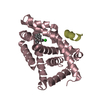

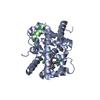


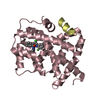
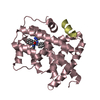
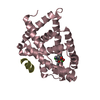
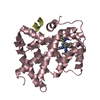
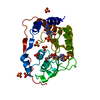
 PDBj
PDBj












